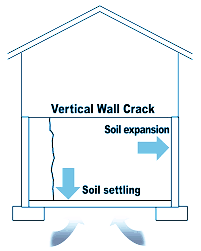Table of Contents
What is Foundation Heave?
Foundation heave is a movement of foundation in upward direction. Basically it happens due to the softening and swelling of the ground.
Factors that cause soil saturation under the foundation are seasonal changes in humidity, aquifers or leaking underground pipes. The economic loss from cruises in the United States has been shown to be greater than the damage caused by tornadoes, hurricanes, floods, and earthquakes combined.

The main cause of foundation swelling in loose soils such as expansion is due to fluctuations in soil moisture. Fluctuation of soil moisture occurs due to the change of field environment due to natural and man-made conditions due to changes in construction works. A building with a thin, light foundation is more susceptible to shaking than a building with a thicker, heavier foundation. The International Association of Certified Home Inspectors states that soil can exert up to 260 KN/m2 stress on concrete.
Causes of Foundation Heave
But the most basis cause of rough seas is moisture. It doesn’t matter if it’s due to weather, an aquifer, or a leaking pipe.
For example, let’s say it’s a hot Tuesday afternoon in August and it’s a dry summer.
The dried up streams are drying up and the lakes are pretty depressed.
A thunderstorm develops and buckets of rain pour down on the ground. It will rain for several days.
Dry-throated soil, especially clay soil, begins to spread. As the soil expands, it expands where it has the lowest pressure.
It turned out that different dirt adhered to the left and right, front, back, and bottom. I have no choice but to go anywhere!
So this earth swells upwards, causing the thirsty sponge to soak up as much water as possible, causing your home to skyrocket. Frost is also a notorious culprit when it comes to primer lifting, a double problem.
Frozen water expands him by 9%. So the ground, which continues to swell with frost, is already stretched, causing the house to tiptoe. It’s not Beuno. So water is the main culprit, but tango needs two. Together, the water and vast soil create an expensive mess.
Symptoms of Foundation Heave
It’s important to remember that wet, expansive soil will have a very difficult time lifting a house. It turns out your house was built to stay in place.
This is what happens when a fairly unstoppable force encounters a very moving object.
As the ground moves up, the foundation moves up putting stress and pressure on the wooden bones of the house hidden behind the drywall and tiles.
Spiral piers are actually the best approach when it comes to protecting your home from bumps in the ground.
How to Repair Foundation Heave?
Spiral piers prevent your house from sinking or lifting because the piers are connected to each other.
Push peers are not chained, they are simply nested. Therefore, if there is buoyancy, the push peer can be detached.
A helical pier keeps your home in place. A rare case where even after the spiral piers are installed, something has to be given and it becomes the foundation of the house, not the earth, so the earth still rises making the uplift worse.
